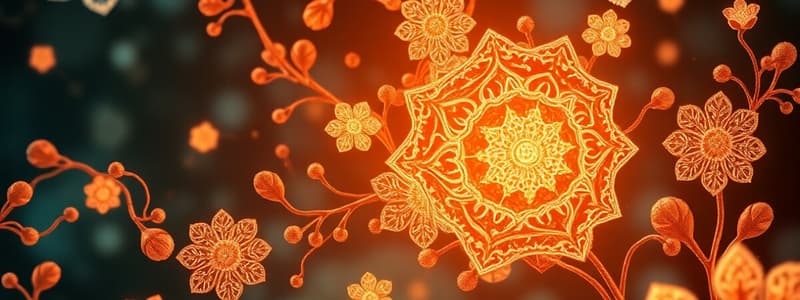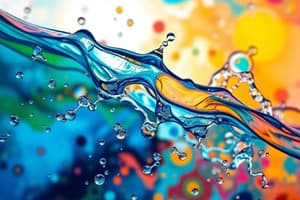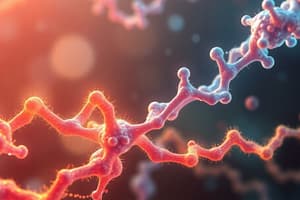Podcast
Questions and Answers
Describe the structure and components of DNA.
Describe the structure and components of DNA.
DNA is a double helix consisting of two strands of nucleotides that are held together by hydrogen bonds. Each nucleotide has a phosphate group, a sugar molecule (deoxyribose), and a nitrogenous base (adenine, guanine, cytosine, or thymine). Adenine pairs with thymine, and guanine pairs with cytosine.
Describe the structure of the sex chromosomes.
Describe the structure of the sex chromosomes.
The sex chromosomes are two chromosomes that determine an individual's sex. Females have two X chromosomes (XX), while males have one X and one Y chromosome (XY). The X chromosome is bigger than the Y chromosome.
Define mitosis, meiosis, mutation, non-disjunction.
Define mitosis, meiosis, mutation, non-disjunction.
Mitosis is a type of cell division that produces two identical daughter cells from a single parent cell. Meiosis is a type of cell division that produces four gametes (sex cells) with half the number of chromosomes as the parent cell. Mutation is a permanent change in the DNA sequence of a gene. Non-disjunction is the failure of chromosomes to separate properly during cell division.
Describe the parts of an atom and how the electrons move.
Describe the parts of an atom and how the electrons move.
Describe different types of bonding.
Describe different types of bonding.
Describe an element.
Describe an element.
Define science.
Define science.
Define biology.
Define biology.
Define hypothesis.
Define hypothesis.
Describe the different types of chemistry?
Describe the different types of chemistry?
Define acidity, basicity.
Define acidity, basicity.
Define eukaryotic cell, prokaryotic cell.
Define eukaryotic cell, prokaryotic cell.
Describe the function of ATP.
Describe the function of ATP.
Describe filtration, diffusion, osmosis, active transport
Describe filtration, diffusion, osmosis, active transport
Define reactant, solution, precipitate, product, compound, chemical reaction.
Define reactant, solution, precipitate, product, compound, chemical reaction.
Give examples of homogenous and heterogeneous mixtures.
Give examples of homogenous and heterogeneous mixtures.
Describe the process of evolution.
Describe the process of evolution.
Describe hydrogen bonding to form water, carbon dioxide carbon monoxide
Describe hydrogen bonding to form water, carbon dioxide carbon monoxide
Define mass, weight, density, solid, liquid, gas, matter, mixture.
Define mass, weight, density, solid, liquid, gas, matter, mixture.
Describe the structure and function of bacteria, viruses.
Describe the structure and function of bacteria, viruses.
Describe the structure and function of an animal cell.
Describe the structure and function of an animal cell.
Organize the biological structures in the human body from smallest to largest.
Organize the biological structures in the human body from smallest to largest.
Describe the function of the skeletal, muscular, respiratory, cardiovascular, immune, integumentary, endocrine, nervous, reproductive, digestive systems.
Describe the function of the skeletal, muscular, respiratory, cardiovascular, immune, integumentary, endocrine, nervous, reproductive, digestive systems.
Describe the anatomy of and blood flow though the cardiovascular system.
Describe the anatomy of and blood flow though the cardiovascular system.
Describe the parts of blood.
Describe the parts of blood.
Describe the types of blood cells.
Describe the types of blood cells.
Describe the types of muscle in the body.
Describe the types of muscle in the body.
Describe the function of insulin.
Describe the function of insulin.
Define fertilization, ovulation, menstruation.
Define fertilization, ovulation, menstruation.
Describe the anatomy and function of the nose, mouth, hair, nails.
Describe the anatomy and function of the nose, mouth, hair, nails.
Describe the categories of plants.
Describe the categories of plants.
Describe the process of water uptake by plants.
Describe the process of water uptake by plants.
Describe the air exchange in a leaf.
Describe the air exchange in a leaf.
Describe the structure and function of a plant cell.
Describe the structure and function of a plant cell.
Describe the function of cellulose.
Describe the function of cellulose.
Describe how plants are pollinated?
Describe how plants are pollinated?
Describe the process of photosynthesis, respiration.
Describe the process of photosynthesis, respiration.
Describe ecosystem.
Describe ecosystem.
Flashcards
Structure of DNA
Structure of DNA
DNA is a double helix made of nucleotides (A, T, C, G).
Sex chromosomes
Sex chromosomes
Chromosomes that determine the sex of an organism (XX for female, XY for male).
Mitosis
Mitosis
Process where a single cell divides into two identical daughter cells.
Meiosis
Meiosis
Signup and view all the flashcards
Atom structure
Atom structure
Signup and view all the flashcards
Types of bonding
Types of bonding
Signup and view all the flashcards
Definition of science
Definition of science
Signup and view all the flashcards
Definition of biology
Definition of biology
Signup and view all the flashcards
Definition of hypothesis
Definition of hypothesis
Signup and view all the flashcards
Types of chemistry
Types of chemistry
Signup and view all the flashcards
Acidity and basidity
Acidity and basidity
Signup and view all the flashcards
Eukaryotic cell
Eukaryotic cell
Signup and view all the flashcards
Function of ATP
Function of ATP
Signup and view all the flashcards
Diffusion
Diffusion
Signup and view all the flashcards
Chemical reaction
Chemical reaction
Signup and view all the flashcards
Homogeneous mixture
Homogeneous mixture
Signup and view all the flashcards
Evolution
Evolution
Signup and view all the flashcards
Plant pollination
Plant pollination
Signup and view all the flashcards
Photosynthesis
Photosynthesis
Signup and view all the flashcards
Bacteria
Bacteria
Signup and view all the flashcards
Function of insulin
Function of insulin
Signup and view all the flashcards
Types of blood cells
Types of blood cells
Signup and view all the flashcards
Muscle types
Muscle types
Signup and view all the flashcards
Animal cell anatomy
Animal cell anatomy
Signup and view all the flashcards
Animal body systems
Animal body systems
Signup and view all the flashcards
Ecosystem
Ecosystem
Signup and view all the flashcards
Study Notes
Biology Equivalency Exam Study Notes 2014
- DNA: Describe its structure and components.
- Sex Chromosomes: Describe their structure.
- Mitosis, Meiosis, Mutation, Non-disjunction: Define each.
- Atoms: Describe their parts and electron movement.
- Chemical Bonding: Describe different types.
- Elements: Describe elements.
- Science: Define science.
- Biology: Define biology.
- Hypothesis: Define hypothesis.
- Chemistry Types: Describe different types.
- Acidity/Basidity: Define each.
- Eukaryotic/Prokaryotic Cells: Define each.
- ATP Function: Describe its function.
- Filtration, Diffusion, Osmosis, Active Transport: Describe each.
- Reactants, Solutions, Precipitates, Products, Compounds, Chemical Reactions: Define each.
- Homogeneous/Heterogeneous Mixtures: Give examples.
- Evolution: Describe the process.
- Hydrogen Bonding: Describe its role in forming water, carbon dioxide, and carbon monoxide.
- Mass, Weight, Density, Solid, Liquid, Gas, Matter, Mixture: Define each.
- Bacteria/Viruses: Describe their structures and functions.
- Animal Cell Anatomy: Describe the anatomy.
- Human Body Systems: Organize biological structures from smallest to largest, and describe functions of skeletal, muscular, respiratory, cardiovascular, immune, integumentary, endocrine, nervous, reproductive, and digestive systems.
- Blood Flow: Describe the anatomy of, and blood flow through, the cardiovascular system.
- Blood Composition: Describe the parts of blood and blood cell types.
- Muscle Types: Describe muscle types in the body.
- Insulin Function: Describe its function.
- Fertilization, Ovulation, Menstruation: Define each.
- Nose, Mouth, Hair, Nails: Describe their anatomy and function.
- Plant Categories: Describe plant categories.
- Water Uptake in Plants: Describe the process.
- Leaf Air Exchange: Describe the process.
- Plant Cell Structure and Function: Describe its structure and function.
- Cellulose Function: Describe its function.
- Plant Pollination: Describe how plants are pollinated.
- Photosynthesis/Respiration: Describe the processes.
- Ecosystem: Describe an ecosystem.
Studying That Suits You
Use AI to generate personalized quizzes and flashcards to suit your learning preferences.




